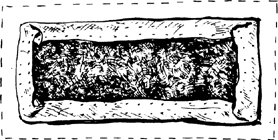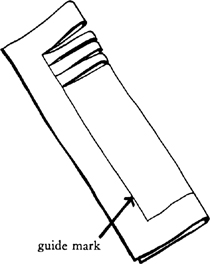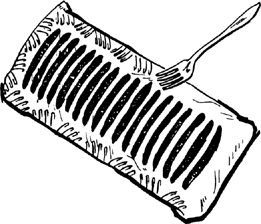Mastering the Art of French Cooking, Volume 2 (66 page)
Read Mastering the Art of French Cooking, Volume 2 Online
Authors: Julia Child

| Turn borders of pastry up over filling at sides; wet corners, and turn ends over |
Roll out second piece of pastry into a 7- by 17-inch rectangle ⅛ inch thick. Flour surface lightly, and fold in half lengthwise. Measure opening of filled pastry and mark folded pastry to guide you. |
|
| Wet edges of filled bottom layer of pastry with cold water. Unfold top layer over it; brush off accumulated flour, and press pastry in place with fingers. |
(*)
AHEAD-OF-TIME NOTE
: When chilled and firm, may be wrapped airtight and frozen for several months. Remove from freezer, glaze, and bake as in Step 2.
2)
Baking and serving—about 1 hour at 450 and 400 degrees
Egg glaze (1 egg beaten in a small bowl with 1 tsp water)
A pastry brush
A table fork or small knife
A rack
A serving tray or board
When oven has been preheated to 450 degrees, set rack in lower-middle level. Paint surface of chilled tart with egg glaze; wait a moment, and give it a second coat. Make cross-hatchings on top of sides and ends through glaze, and set in oven. In about 20 minutes, when pastry has risen and started to brown, turn oven down to 400 degrees. Cover loosely with foil or brown paper if surface is browning too much. Sides should be firm and crusty. Slide onto a rack when done. Serve warm or tepid, cutting into crosswise slices.
(*) Tart is best when freshly made, but you can store it for several hours in a warming oven at about 100 degrees.
Garnitures for Bouchées and Vol-au-Vent

RIS DE VEAU À LA FINANCIÈRE
[Braised Sweetbreads Garnished with
Quenelles
, Truffles, Mushrooms, and Olives]
This is certainly one of the great classic fillings for
bouchées
and large
vol-au-vent
, and delicious when properly done. Unfortunately, like Beef Wellington in the hands of the profane and cynical, gummy sauces, clumsy flavoring, and bad pastry have ruined its reputation. We urge you to give it another try, and you will understand why it has long been so popular with great chefs. You may not want to add all of the items listed, but you will have a delicious creamed sweetbread filling even if you do not do the full
financière
, which could also include cockscombs and white kidneys (
crêtes et rognons de coq
), although we have not listed them in the ingredients.
MANUFACTURING NOTE
This is the kind of filling that you can prepare the day before serving. We shall not give proportions of how much filling is to go into each pastry, because there is no way of knowing what size and how many you are to make; leftover filling will be just as good the next day, with scrambled eggs or as the filling for an omelette.
For about 1½ quarts, serving 6 to 8
1)
The sweetbreads and the sauce base
2 lbs. soaked and peeled sweetbreads braised in wine, stock, and aromatic vegetables, Volume I, page 410
2 cups fresh baby mushrooms, or larger mushrooms quartered
2½ cups liquid as follows: the cooking stock from the sweetbreads plus half veal or chicken stock and half milk to complete the measure
A heavy-bottomed 3-quart saucepan, enameled or stainless





